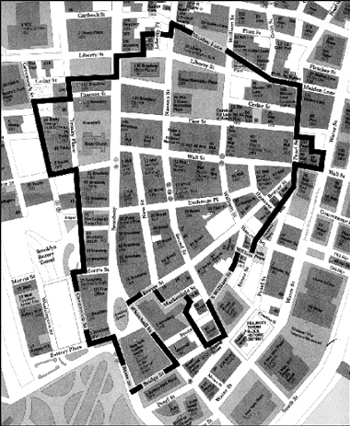By Skye H. McFarlane
Few places in the United States contain as much history as the southern tip of Manhattan. Over the past five centuries the area has played host, successively, to the Lenape Indians, the Dutch settlers, the British Empire, the first capital of the United States, the heart of the global economy, and now, a re-burgeoning residential population.
In honor of that history, and the architectural legacy it has left behind, the National Parks Service on Monday announced that 36 blocks of what we now call the Financial District will be listed on the National Registry of Historic Places. Though a National Registry designation is far less restrictive than a city Landmarks designation, the federal title does offer preservation protection for any project involving federal money, as well as tax incentives to encourage private citizens to restore and preserve their buildings.
According to Steve McClain, president of the National Architectural Trust, roughly 25 percent of the buildings in the new Wall Street Historic District are already protected by the New York City Landmarks Preservation Commission, either as individual landmarks or as a part of two smaller historic districts. Unlike city landmarking, the federal designation does not prevent a building from being demolished or force an owner to consult the government before making changes to the building’s appearance. The weaker regulations, McClain said, stem from the Constitution’s protections against the federal government interfering with personal property.
While many building owners welcome city landmarking because it increases the prestige of their property and protects it from damage by neighboring construction projects, other owners resist designation because of the restrictions it places on future development. Therefore, the less onerous regulations and tax incentives offered under the Federal registry can make some property owners more receptive to a “historic” label. According to McClain, several Downtown businesses, including the Wall Street-based Pyne Companies and Stellar Management, joined the Trust and the State Historic Preservation Office in the 18-month campaign to create the Wall Street district.
“With the architecture, the aesthetics, the economic impact, Wall Street is absolutely a sterling example of the criteria that the National Parks Service is looking for,” McClain said.
With a boom of redevelopment in Lower Manhattan, McClain said that it was the perfect time to introduce the registry’s preservation tax incentives. One incentive gives a tax credit worth 20 percent of the cost of restoring or preserving a “significant” building within the district, provided that the work meets the standards of the State Historic Preservation Office and the N.P.S.
The other incentive, called an easement, allows a building owner to symbolically donate the façade of their building to the trust. After an independent appraiser determines the value of the “donation,” the building owner can claim the amount as a charitable contribution on his or her tax return. In exchange, the landlord and any future owners of the building become contractually obligated to maintain and preserve the façade.
“We’d like them all to do it,” McClain said of the voluntary easements. “What we’re trying to really do is use this program to maintain a sense of place…What’s good is that the aesthetics at the moment have been in line with the historic preservation. People like the neo-classical and beaux-arts design. The time to put these easements on is when these are the aesthetics that people desire.”
Preservationists and politicians at the Monday announcement, including Rep. Jerrold Nadler, hailed the designation. However, the Downtown Alliance, which runs the Lower Manhattan business improvement district and supported the city’s effort to landmark Financial District buildings over the last decade, had a more tepid reception to the news.
Eric Deutsch, president of the Alliance, said that the tax incentives could be helpful in encouraging building owners to invest in their structures. However, because a great deal of Downtown development is being financed by federal money, including post-9/11 grants and bonds, Deutsch warned that a large number of projects could be subject to the National Parks Service review process — making the federal registration operate more like a stricter city designation.
Deutsch hopes that the additional reviews will not block or stall the ongoing revitalization in the area, including city infrastructure improvements like the Fulton Transit Center and the Alliance’s own project to revamp Downtown streetscapes with uniform lighting and sidewalk improvements.
“There’s upside and downside,” said Deutsch. “It’s potentially beneficial, but hopefully the added regulatory requirements will not impede the progress Downtown. We’re hopeful that they won’t.”
Skye@DowntownExpress.com
































